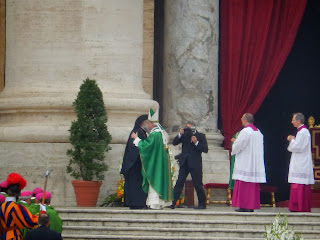I got up and went to the Vatican for Mass. (Casually throwing that out there.) I honestly had no plan and no expectation of what I was doing, but everyone else was either asleep or out and I figured I needed to find a church...so why not St. Peter's? I followed a swelling crowd until I reached the great Tiber River, the lifeblood of the ancient city. Crossing over the Tiber, I literally ran smack into the Vatican City, which was already being blocked off for Mass. I slipped past crowds and officers until I got close enough to hear and see what was going on at the altar (it was standing room only by this point). Someone was reciting the rosary in Latin over a major speaker system, and several huge television screens were ready to go for the papal Mass. It seemed incredibly surreal to me that I had just woken up about an hour before and decided basically on a whim to waltz down here, but I didn't have much time to think about it; Mass started very soon afterward, and with it came Papa Francesco himself. Most of it was in Italian and Latin, with the first reading in French and the second reading in Spanish, but there were a few announcements in English which I appreciated. (I was hoping to understand enough Italian to figure out what the readings were, but all I really caught were "faith" and "hand." Not overly helpful.)
Il Fiume Tevere (Tiber River)
Here he comes!
Greeting an Orthodox official
Opening prayer
Approaching St. Peter's
When it came time for communion, dozens of priests were sent into the crowd to distribute the Eucharist, first to the people sitting down (who'd arrived HOURS before I had) and then to the people standing in back like me. It reminded me a lot of my World Youth Day experience in Madrid 2011: people of all ages, cultures, languages, and backgrounds gathering to receive; quietly working together to make sure as many people as possible got to the front of the throng; hearing "The Body of Christ" in a language that was not your own but knowing what was said anyway. At one point the priest distributing communion gave the bowl to a French priest in the crowd, who could reach more people. One elderly Italian woman helped push me to the front when it was my turn. On the whole, it was an incredibly beautiful and moving experience - especially with this particular pope presiding - that left me smiling.
After the Mass, the pope greeted several people (including someone who looked like an official from one of the Orthodox churches) and then got into his PopeMobile - without the protective roof! He drove through the crowd, waving and smiling, stopping to kiss a baby that somebody half-threw at him and pausing to embrace a child with special needs and his mother. He looked incredibly pleased that we were all there and seemed very grandfatherly - and I mean that in the best way. It was pretty thrilling.
When the pope had gone back to the basilica, I walked back toward the Campo de' Fiori, stopping briefly at an organic market on the way that sold cheeses and breads and different homemade sauces. Instead of turning back toward the hotel, though, I kept going until I reached the Jewish Ghetto. Today it's a vibrant neighborhood full of the rich Roman Jewish culture (including lots of kosher restaurants), but for many centuries it was a place of grim confinement where Jews were kept separate from the Christian population. Pope Paul IV instituted the ghetto in 1555, building a wall around one of the wettest and least desirable places in the city for the Jewish community to inhabit. And under the Nazi occupation of Italy, the ghetto was emptied in 1943, with most of its inhabitants never returning from the concentration camps. There are many reminders of the ghetto's tragic past throughout the neighborhood.
Found on a wall in the Jewish Ghetto with the date "16 Ottobre 1943"
Commemorating the deportation
A collection of Jewish heritage
Plaque describing October 16, 1943 (The seventieth anniversary is this year)
"SPQR" on a plaque commemorating the destruction of a Christian church by the Nazis near the ghetto
There are also some impressive ancient ruins that sit right next to the ghetto. The Portico of Octavia, built by Augustus in honor of his sister, is still relatively intact from its glory days, along with the Theater of Marcellus, which looks almost like a miniature Colosseum from the side. Both were incorporated into the medieval Roman life, with the Portico being part of the fish market and the Theater of Marcellus eventually incorporated into modern building structures. Take a look:
Portico of Octavia
Remains of a temple next to the Portico
Theater of Marcellus
Theater of Marcellus (looks like a mini Colosseum!)
Well, thanks for joining me, amici. I promise I'll start including more colloquial information soon. Can't help myself with the history, though. :) Have a great rest of your day!




















No comments:
Post a Comment